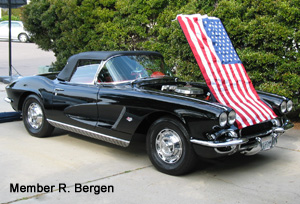The '62 Corvette is considered by many experts to mark a high point in the 52-year history of the nameplate, and not without good reason. If you really think about it, the '62 Vette represents the "Best of Both Worlds." Not only was it the last Vette based on the original “sports car” platform and the last of the "straight axle" cars, but, when equipped with the newly-available fuel-injected 327-cid, 360-hp V-8, it was a preview of what was to come, performance-wise, in the later ‘60s. The ’62 Vette was the ideal combination of brawn and beauty, much like the split-window coupe that would be introduced the following year.
Design-wise, the '62 Corvette was essentially a carryover from the previous year's model, with the exception of some changes such as narrow-band whitewall tires. At the same time, the new Vette previewed some upcoming innovations, such as chromed rocker panels and a new rear-end treatment, both of which were integrated into the design of the 1963-1967 models.
Underneath the hood is where the '62 really set itself apart. The transmission choices might have been the same as before, with a 3-speed manual standard, and an automatic and a four-speed manual available as options, but the engine was a brand new . . . or more accurately, a newly tweaked . . . Chevy small-block V-8. Taking a cue from hot rodders, Duntov & Company modified the 283, bumping the displacement up to 327 cid. The result was not only the best engine in the small-block family, but also one of the best engines ever made.
The 327 was the only engine that came in '62 Corvettes and it came four different ways. The base 327 was rated at 250 hp. It had a 10.5:1 compression ratio and carried a four-barrel Carter AFB carburetor. For an additional $53.80, the buyer could step up to an RPO 583, which was good for an additional 50 horses. If that wasn't enough power, RPO 396 with 340 hp and an 11.25:1 compression ratio was available. Last, but not least, an additional $484.20 would make your '62 'Vette a "fuelie" with the RPO 582, 360-hp version of the 327.
The 327 has always had a great reputation in both passenger-car and high-performance formats, especially when fuel-injection is part of the equation. The numbers back it up. With a 0-30 time of just 2.5 seconds, a 5.9 second 0-60, a 13.5 second sprint from 0-100, a 14.5 second run through the traps and a top speed in the neighborhood of 150 mph, GM succeeded in doing what they had been doing ever since the Corvette was first introduced: In short, the General took something good.and made it better.
With vast improvements over the ‘61, particularly the new 327, the ‘62’s base price was only marginally higher at $4,038 (a $104 increase). No wonder the year turned out to be the Corvette’s best sales season ever, with a total of 14,531 Vettes leaving Chevy showrooms.
’62 VETTE FACTS
|
|
|
VEHICLE IDENTIFICATION NUMBER
|
Convertibles for 1962 were numbered 20867S100001 to 208672S114531. The first symbol 2 indicated model year. The second and third symbol identified the body series 08 = Corvette. The fourth and fifth symbol indicated the body style 67 = 2 door convertible. The sixth symbol identified the assembly plant S = Saint Louis. The last six symbols indicate the sequential production number.
|
|
ENGINE
|
BASE ENGINE
Type: V-8
Bore and stroke: 4.00 x 3.25 in.
Displacement: 327 cid
Brake hp: 250 at 4400 rpm.
Induction: Carter Type AFB 4-bbl
OPTIONAL ENGINES:
327-cid/300-hp w/Carter AFB 4-bbl
327-cid/340-hp w/Carter AFB 4-bbl
327-cid/360-hp w/Fuel injection
|
|
VITAL STATS
|
Convertible
Original Price: $4,038
Production: 14,531
Wheelbase: 102 in.
Length: 177.2 in.
Tires: 6.70 x 15
|
|
COOL STUFF
|
• The conventional trunk design of the 1962 was the last for many years.
• Last year for exposed headlights, solid rear axles and electrical generators.
|